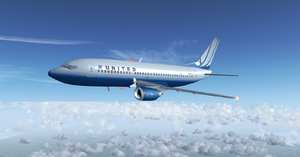Boeing 737
| There is a category with screenshots of the Boeing 737. |
The Boeing 737 is a short to medium range, single aisle, narrow body jet airliner. Originally developed as a shorter, lower cost twin engine airliner derived from Boeing's 707 and 727, the 737 has nine variants, from the early -100 to the most recent and largest, the -900.
First envisioned in 1964, the 737 entered service in 1968. Forty years later it has become the most ordered and produced commercial passenger jet in the world. It is Boeing's last surviving narrow-body airliner, sometimes serving markets previously filled by 707, 727, 757, DC-9 and MD-80/90 airliners. Continuously manufactured by Boeing since 1967 with 9,295 aircraft delivered and 4,280 orders yet to be fulfilled as of November 2016, there are over 1,250 737s airborne at any given time. On average, a 737 departs or lands somewhere every five seconds.
Procedures
The take off precedure for a 737 is to have flaps set at 5, and power up to 40% N1 till moving, the slowly build up to 94-96% N1, pull when Vr and keep at 15degrees pitch, retract gear when positive climb rate
Takeoff Speeds Flaps 5
| TOW KG | TOWlbs
|
V1
|
VR
|
V2
|
| 65K | 143000
|
154
|
155 |
160
|
| 60K | 132000
|
147
|
148 |
154
|
| 55K | 121000
|
140
|
141 |
148
|
| 50K | 110000
|
133
|
133 |
141
|
| 45K | 99000
|
123
|
133 |
133
|
| 40K | 88000
|
114
|
114 |
126
|
| 35K | 77000
|
104
|
104 |
117
|
Landing Speeds with following flaps settings
| TOW KG | TOWlbs
|
40
|
30
|
15
|
| 65K | 14300
|
152
|
153 |
165
|
| 60K | 132000
|
145
|
147 |
158
|
| 55K | 121000
|
138
|
141 |
151
|
| 50K | 110000
|
131
|
134 |
144
|
| 45K | 99000
|
123
|
127 |
136
|
| 40K | 88000
|
115
|
119 |
128
|
| 35K | 77000
|
107
|
111 |
119
|
Maximum Flap Operating Speeds
1 = 230 kn
2 = 230 kn
5 = 225 kn
10 = 210 kn
15 = 195 kn
25 = 190 kn
30 = 185 kn
40 = 158 kn
Landing Gear Limits
Extend 270IAS/ 0.82M Retract 235IAS
Variants
- Boeing 737-100
- Boeing 737-200
- Boeing 737-300
- Boeing 737-400
- Boeing 737-500
- Boeing 737-600
- Boeing 737-700
- Boeing 737-800
- Boeing 737-900ER
- Boeing 737-7 MAX
- Boeing 737-8 MAX
- Boeing 737-9 MAX
| |||||||||||
